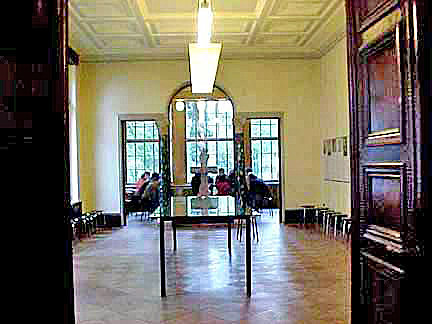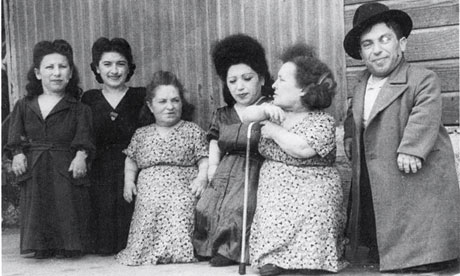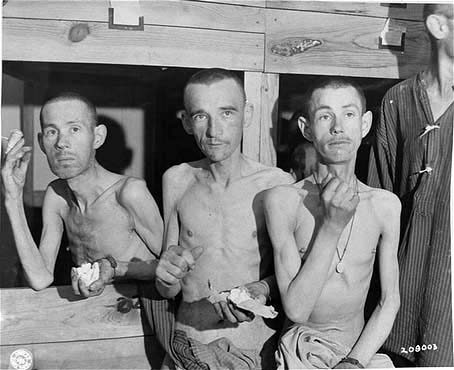Today I am expanding on a blog post written by The Black Rabbit of Inlé, one of my regular readers: http://winstonsmithministryoftruth.blogspot.co.uk/2013/08/goerings-execution-was-foregone.html?zx=649975c9486c2a32
This quote is from the blog post, cited above:
November 20, 1945 was the opening day of the Trial of the Major war Criminals at Nuremberg, but a letter written by [Sir Hartley] Shawcross on November 4, 1945 reveals that he knew Goering was going to be executed at the end of it.
The Nuremberg trials, which started on November 20, 1945, are called “show trials” because the outcome was known before the trials began.
The first and best known of the show trials was the “Trial of the Major War Criminals Before the International Military Tribunal.” This was the show trial of the 24 most important captured leaders of Germany. It was held from November 20, 1945 to October 1, 1946. The photo above shows Hermann Goering on the far left, with Rudolf Hess sitting next to him. On the far right is Ernst Kaltenbrunner.
Bombing Germany back to the stone age was not enough revenge for the Allies; they had to put on show trials.
The first trial, before the International Military Tribunal, had prosecutors and judges from the United States, Great Britain, France and the Soviet Union. A second set of trials, known as the Nuremberg Military Tribunals, was conducted by the United States only. The most famous of these trials were the Doctors’ Trial and the Judges’ Trial.
The Trial of the Major War Criminals began on November 20, 1945 when British judge Sir Goeffrey Lawrence called the court to order, saying “This trial, which is now about to begin, is unique in the annals of jurisprudence.” The trial ended nine months later on October 1, 1946.
The trial was unprecedented because the prosecutors who conducted the trial and the judges who made up the jury were both from the victorious Allies only. The International Tribunal and the charges against the Germans had been created under the terms of an agreement among the Allies, known as the London Charter, signed on August 8, 1945.
At the main trial, there were 100,000 documents accepted into evidence and the transcript of the trial filled 42 volumes with more than 5 million words. According to the US Holocaust Memorial Museum, Allied prosecutors submitted some 3,000 tons of records at the Nuremberg IMT. The defense was not allowed access to any documents except the ones that were actually used by the prosecution.
Nürnberg [Nuremberg] was famous for producing toys and gingerbread cookies, not war materials; it was the ideological center of Nazi Germany and Hitler’s favorite city. Nürnberg was regarded as the “most German” of all the cities in Germany, which made it a target for vindictive Allied bombing.
On the night of January 2, 1945, 514 British Lancaster bombers and 7 other British planes destroyed or damaged most of the old city, including the medieval walls, the historic castle and two centuries-old Gothic churches. At that point in the war, it was the most devastating air-raid attack on a civilian population and only the Allied bombing of Dresden, six weeks later, caused more damage and civilian deaths in Germany.
One wing of the Palace of Justice had to be restored by the forced labor of German prisoners, so that the show trials could be held in Room 600.
You can read about why the Nuremberg IMT is called a “show trial” at http://en.metapedia.org/wiki/Nuremberg_show_trials
I previously blogged about the start of World War II, as presented at the Nuremberg IMT at https://furtherglory.wordpress.com/2010/02/24/alfred-naujocks-and-the-start-of-world-war-ii/
The entire Nuremberg International Military Tribunal trial was captured on film and shown to the world on TV. Newsreel films showed the city of Nürnberg as a pile of rubble, which had not yet been cleared when the trial started; the bodies of 20,000 German civilians were still buried under the destroyed buildings as the German war criminals were brought into the courtroom of the Palace of Justice. The Palace of Justice had suffered some damage in the Allied bombing of Nürnberg, but it had been restored by the forced labor of the conquered Germans before the trial began.
It was at the Nuremberg trials that the whole world learned for the first time about the German atrocities, including all the gory details of the shrunken heads, the soap made from human fat, the leather goods made from the skin of concentration camp prisoners, and the gas chambers which accounted for the majority of the deaths at Auschwitz and Majdanek, where the Russians testified that not less than 4 million people had died in the Auschwitz complex and another 1.5 million had died at the Majdanek camp. Today, the figures given for these camps is 1.1 million deaths at Auschwitz and 78,000 at Majdanek, including 59,000 Jews.
The horror films of the Allied liberation of the Nazi concentration camps at Bergen-Belsen, Buchenwald and Dachau were shown at the trial, to the defendants and to the public. An American-made documentary film, which showed all the graphic details of the gas pipes and control wheels which regulated the flow of poison gas through the shower heads of the Dachau gas chamber was shown in the courtroom on November 29, 1945. I blogged about the Dachau gas chamber film at https://furtherglory.wordpress.com/2010/11/19/proof-of-the-nazi-gas-chambers-given-at-the-nuremberg-imt-on-nov-29-1945/
The Nuremberg IMT was more than just a trial. It was a graphic presentation to the entire world that the Allies had fought “the Good War” against the evil Nazis.
The following quote is from the web site of the United States Holocaust Memorial Museum:
The goals of the International Military Tribunal (IMT) transcended verdict and punishment. The creators of the court were deliberately assembling a public record of the horrific crimes committed by Germans during World War II, including those of the Holocaust. American chief prosecutor Robert Jackson worried that “unless record was made future generations would not believe how horrible the truth was.”
In order to avoid any accusation of exclusive reliance on personal testimony, which later generations might perceive to be biased, prosecutors decided to base their case primarily on thousands of documents written by the Germans themselves. These masses of documents were translated into the court’s four official languages, analyzed for their significance, and reproduced for distribution to defense attorneys and other trial participants. The prosecution presented other evidence through artifacts, diagrams, and photographs taken by Nazi photographers in concentration camps.
On the third day of his cross examination of Hermann Goering, American prosecutor Robert Jackson questioned him about the treatment of the Jews in Nazi Germany, including the anti-Jewish Nuremberg Laws on Citizenship which Goering had signed in September 1935.
Then Jackson confronted Goering with the most incriminating piece of evidence in the entire trial: a letter dated July 31, 1941, in which Goering had ordered Reinhard Heydrich, the chief of the Reich Security Main Office (RSHA), to prepare a plan for the “Final solution of the Jewish question.” Goering testified that the German term “Die Endlösung” in the letter should have been translated as the “total solution,” and that it referred only to “the emigration of the Jews,” not the extermination of Jews.
The Protocols of the Wannsee Conference, at which the “Final Solution” was planned, were not found until 1947, so this important document was not included in the mountain of evidence introduced at the International Military Tribunal at which the German war criminals were tried for Crimes against Humanity.
Some people today claim that the Wannsee Conference never took place. Since the minutes of the meeting were not found until 1947, this is entirely possible. Adolf Eichmann was the man who allegedly wrote the minutes that were not found until 1947. He was put on trial in Israel so that he could elaborate on the plan to genocide the Jews, now known as “the Final Solution.”
The photograph above shows the large dining room of a villa on the Grossen Wannsee, a lake in the Wannsee suburb of Berlin, where the Conference on “The Final Solution of the Jewish Question” was held on January 20, 1942. This is the room where the plans for the genocide of the Jews were discussed. The villa is now a Holocaust Museum.
For the most part, the International Military Tribunal charged the defendants, not with individual responsibility for specific crimes, but with a “Common Plan” to commit crimes.
According to the book Justice at Nuremberg by Robert E. Conot, the idea for the Common Plan charges against the Germans came from Lieutenant Colonel Murray C. Bernays, a Lithuanian Jew who had emigrated to American in 1900 at the age of six.
Before the trial, according to Conot’s book, Churchill and Roosevelt’s adviser Henry Morgenthau, Jr. had advocated that “the principal Nazi leaders should be charged with their crimes, then summarily shot.” Bernays argued for a trial as “the educational and therapeutic opportunity of our generation.” Regarding the Nazi crimes, Bernays wrote “The crimes and atrocities were not single or unconnected, but the inevitable outcome of the basic criminal conspiracy of the Nazi party.”
There was nothing in international law which allowed a charge of participating in a “Common Plan.” The Nuremberg trials were conducted on the basis of new laws that were made up by the Allies AFTER the war, specifically for the German war criminals.
Any atrocities committed by the Allies were not considered war crimes. After the war, France passed a law that no French citizen could be charged with a war crime.
The Nuremberg trial had far-reaching consequences — for America and the world. In 1948 President Harry Truman desegregated the American armed forces, and in 1954 after the U.S. Supreme Court ruled that school segregation was unconstitutional, Justice Robert Jackson, who participated in the decision, said that the Nuremberg experience and the “awful consequences of racial prejudice revealed by … the Nazi regime” had influenced his decision.
According to Conot’s book, before the Nuremberg International Military Tribunal proceedings began, there was no international criminal code; the barbaric practices of the Nazis became war crimes under international law, only after the IMT proceedings, when the United Nations passed the Genocide Convention and a Declaration of Human Rights.
After World War II, the rules of warfare changed: reprisals can no longer be taken against hostages or Prisoners of War; forced labor is now outlawed; captured partisans are given equal status with POWs. The Germans had been convicted of all these crimes before they were crimes. The verdicts at the Nuremberg IMT established international law and the actions of the Germans in World War II are now war crimes.
Regulations of all the major World War II armies now state that orders which would constitute the commission of a crime need not be obeyed. All the crimes that were revealed at the Nuremberg trial have now been incorporated into international law and the defense used at the Nuremberg trial by the German generals and admirals that they were just obeying orders is no longer valid.




































